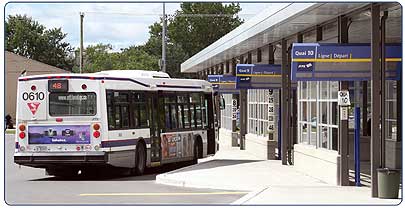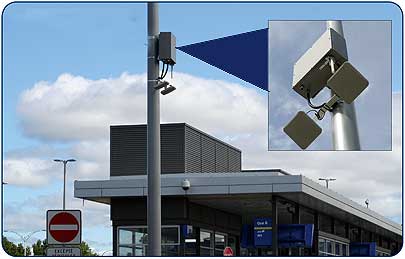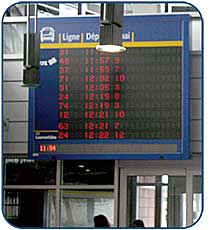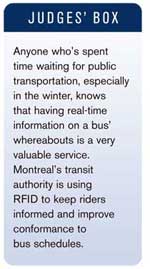Award Winner: Best Use of RFID in a Service
June 1, 2008—Montreal has often been described as North America’s most cosmopolitan city: a combination of Old World style and sophistication mixed with New World excitement and innovation. Today, this culture blend is even evident in the city’s mass transit system, where, with the help of RFID technology, buses now run with European efficiency and precision, and passengers are kept comfortable and informed.
As Montreal’s reputation as a vibrant and livable city has grown over the past several years, so has its population. While rapid growth has invigorated the region’s business, recreational and cultural activities, it has also flooded area streets, highways and bridges with private vehicles, slowing transportation to a crawl. To get Montreal moving again, public officials want more people to use public transit.
Responsibility for helping the Montreal area’s public transit system meet the demands created by a growing population belongs to the regional transit agency, Agence métropolitaine de transport (AMT). The organization, which reports directly to the Quebec provincial government, manages five commuter train lines, two regional bus routes, 15 bus terminals, 84 kilometers of reserved traffic lanes and 60 park-and-ride lots. The agency also is in charge of planning, improving and promoting public transit services in cooperation with 13 local transit authorities.
Although Montreal already has a large number of commuters riding on public transit—second in North America only to New York City—AMT felt there was still ample room for improvement. “We want to have even more people use transit,” says Claude Carette, AMT’s vice president of metropolitan infrastructures. Yet convincing people to abandon their vehicles for buses and trains would require something more than building new roads and rail lines. Technologies would be needed to make the public transit experience more convenient and comfortable. “We knew we would have to try new things,” Carette says.
In 2006, as AMT began to address rapidly mounting street congestion problems, the agency’s managers realized they needed to take swift action. They began by focusing on bus transportation. After analyzing the situation, the organization established three basic goals:
• Provide riders with real-time information to help them catch buses without spending any longer than necessary waiting for the bus to arrive.
• Offer supervisors insightful management tools that would help them better manage service disruptions caused by buses delayed due to accidents, traffic, weather and other events.
• Compile detailed and cumulative reports with data that could help planners improve route and personnel management, leading to better service, improved efficiency and cost savings.
AMT managers spent the next several months scrutinizing proposals from numerous vendors to see which plan would work best to help them achieve their goals. The agency eventually decided that an approach suggested by Solotech International, a Montreal-based multimedia design and systems integration firm, made the most sense. Solotech proposed that AMT start its bus rider support and congestion relief plan by giving people real-time transit information on massive digital displays mounted inside bus terminals. “But first we needed systems to be sure that we knew when the bus is going to come into the bus terminal—if it is late or not,” Carette says. “We needed something to detect the buses in real time.”
The partners knew they would have to find a data-gathering technology that could work reliably and cost-efficiently under a wide range of weather conditions; heavy snow, bitter-cold temperatures and bright sunshine can all be found in Montreal on any given day. “That was the most difficult thing for us,” Carette says.

Earlier research showed that infrared and other technologies delivered disappointing performance and accuracy results in public transit environments, so it was no surprise that the partners’ thoughts quickly turned to RFID, a solution that had been presented by Eminencia Group, an RFID systems integrator based in Montreal. RFID had already proved its ability to deliver reliable results in some of the world’s harshest environments.
To supply the new system’s location and tracking technology, Solotech and Eminencia developed a state-of-the-art detection system. “Our team has many years of knowledge and practice in automatic identification and data collection and information technology, as well as expertise in RFID technology,” says Pierre Malboeuf, Eminencia’s president. “We were also in the neighborhood, so we knew the area and its challenges very well.”
AMT decided that its first venture into RFID would be folded into a larger project designed to bring additional transit services—including an extended subway line—to the northern suburb of Laval. “The subway has three stations, and at two of those stations there are bus terminals,” Carette says. The two terminals, Cartier and Montmorency, were selected to be wired for RFID and to receive the giant digital displays.
The final plan called for RFID interrogators to be mounted on lampposts at the entrances of each terminal. The units would read the unique ID numbers on tags attached to the 400-plus buses assigned to the terminals. The data, along with a time stamp, would be relayed to a server inside the terminal. The system would then match each ID number with the corresponding bus route contained in the agency’s database. Dock-mounted interrogators, installed inside multifunction utility boxes, also would be deployed to record the exact time each bus arrived and departed.
Since buses can approach either side of the dock, four antennas would need to be linked to each dock’s interrogator. The dockside readers would allow dock assignments to be changed rapidly and efficiently, so incoming buses could drive up to the most appropriate and convenient spot.
RFID would allow the system to know when a specific bus was nearing its assigned dock. The information would then be displayed on the terminal’s digital screens, alerting commuters (waiting comfortably inside the terminal) and giving them sufficient time to walk to the dock and board the bus.

In the Driver’s Seat
Before the system’s planning was concluded, AMT imposed some heavy requirements on its partners. It demanded, for instance, that tags would have to be mounted on the buses so that they would be inconspicuous yet readable at distances of at least 45 feet and, at terminal entrances and exits, at speeds no less than 40 miles per hour. In addition, tests would have to be conducted to ensure that cross-reads wouldn’t be a problem, and people waiting in the terminal would receive consistent and reliable information.
To help meet AMT’s functionality and durability requirements, and to ensure that the system could cope with Montreal’s harsh weather, heavy traffic and other environmental conditions, Eminencia recommended deploying a system using passive EPC Gen 2 ultrahigh-frequency tags, which provide more reliable read rates over longer distances than alternate technologies. Eminencia tapped Motorola to supply most of the system’s RFID hardware. The communications giant provided its RFID cargo tags, XR-series UHF interrogators and AN200 general-purpose indoor/outdoor antennas.
Mounting the tags on a side window on each of the buses proved to be the best way to ensure that the devices would be inconspicuous yet electromagnetically visible to interrogators. But installing tags on glass meant that conventional mounting hardware, such as nuts and bolts, couldn’t be used. Instead, the tags are literally taped to the windows with double-sided 3M adhesive tape—a sort of super duct tape—which is designed to cope with a wide temperature and humidity range, as well as sunlight, cleaning chemicals, and other man-made and environmental forces.
The interrogators, fully exposed to the elements, were another vulnerable system component. The devices were cocooned inside NEMA (National Electrical Manufacturers Association) boxes, allowing them to function at temperatures as low as minus 40 degrees and as high as 110 degrees Fahrenheit.
Driving Into the Future
AMT and its passengers began enjoying the system’s benefits the moment it was turned on in April 2007, Carette says. Ridership is already up, with more than 50,000 people using the expanded subway/bus facilities every day. “A number of people have mentioned that they wouldn’t be on the buses if it weren’t for their ability to wait in comfort inside the terminal rather than at the dock,” Malboeuf says.
Moreover, alerting passengers to bus arrival and departure times isn’t the system’s only positive attribute. The data gathered by the technology also meets the project’s other goals of providing real-time bus location data and enhancing route planning and management. The system allows managers to make on-the-spot decisions about when to send buses and drivers on a particular route in order to keep pace with rider and traffic demands. Supervisors are equipped with dual displays that show both the planned schedule and the status and location of buses currently on the streets. “Normally, the bus booking and driver booking is planned [in advance],” Carette says, “but now they can make adjustments in real time.” That helps keep the buses on a precise schedule.

Thanks to careful planning, the partners were able to deploy a relatively glitch-free system. Even when problems were discovered, things eventually turned out OK. For example, as the system was being deployed, AMT discovered that while designers had provided Ethernet connections to the dockside interrogators, there were no data links leading to the lamppost readers at the terminals’ entrances and exits.
Fixing this problem using conventional network cables would have been a costly and time-consuming process. Instead, the partners realized that the information could be carried just as efficiently, and at a far lower cost, with a point-to-multipoint Wi-Fi solution. Eminencia installed Motorola’s AP-5131 wireless access points and CB3000 wireless bridge adaptors. “It was one of those times when something good actually comes out of a bad situation,” Malboeuf says.
The current system represents the first phase of what promises to become a much larger RFID deployment. AMT is already planning to expand its RFID system. “We have two other major bus terminals where we want to have real-time information [provided] to our customers,” Carette says. One of these projects will be technically challenging, since it will involve 21 underground bus docks located beneath a building. “It’s a big project,” he says, “but we and the technology will be able to cope with it.”
As the Montreal area’s RFID network grows, data analysis will allow AMT supervisors to provide more detailed information to waiting riders. “Instead of telling people that the bus is just arriving or hasn’t yet arrived,” Carette says, “we’ll be able to say in advance that it will be a certain number of minutes early or late.”
For now, AMT is satisfied that it has deployed the best system possible within existing technology, budget and time limits. The entire project, including the subway extension, has won nearly universal applause. “Everybody here in the Montreal area—politicians, technicians and the people—is pretty amazed at the success of this project,” Carette says. “We are, too.”


